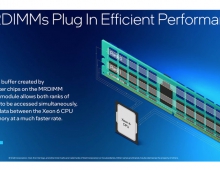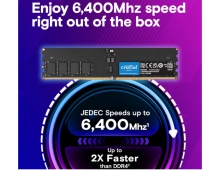
Intel To Invest $8B on US 22nm Chip Manufacturing, Unveils Future Chips
Intel announced today that the company will invest between $6
billion and $8 billion on future generations of manufacturing
technology in its American facilities.
The action will fund deployment of Intel's next-generation 22-
nanometer (nm) manufacturing process across several existing
U.S. factories, along with construction of a new development
fabrication plant (commonly called a "fab") in Oregon. The
projects will support 6,000 to 8,000 construction jobs and
result in 800 to 1,000 new permanent high-tech jobs.
"Today's announcement reflects the next tranche of the continued advancement of Moore's Law and a further commitment to invest in the future of Intel and America," said Intel President and CEO Paul Otellini. "The most immediate impact of our multi-billion-dollar investment will be the thousands of jobs associated with building a new fab and upgrading four others, and the high-wage, high-tech manufacturing jobs that follow."
Intel?s brand-new development fab in Oregon - to be called "D1X" ? is scheduled for R&D startup in 2013. Upgrades are also planned for a total of four existing factories in Arizona (known as Fab 12 and Fab 32) and Oregon (known as D1C and D1D).
While Intel generates approximately three-fourths of its revenues overseas, it maintains three-fourths of its microprocessor manufacturing in the United States. This new investment commitment also allows the company to maintain its existing manufacturing employment base at these sites.
This new capital expenditure follows a U.S. investment announcement made in February 2009 to support upgrades to its manufacturing process. Those upgrades resulted in 32nm process technology which has already produced computer chips being used today in PCs, servers, embedded and mobile devices around the world. Intel's first 22nm microprocessors, codenamed "Ivy Bridge," will be in production in late 2011 and will boost further levels of performance and power efficiency. Ivy Bridge will be the follow-on to Sandy Bridge. Ivy Bridge will not only have a smaller footprint. It will take Moore's Law and add more transistors, which means more features and generally you have lower power. Ivy Bridge is like a second generation Sandy Bridge.
Intel is also working on even more advanced manufacturing processes in its labs. The Oregon's fab is targeted at 15 nanometers and beyond (11 nanometers, and 8 nanometers). The 15nm chips are not expected to appear earlier than 2013.
Of course, don't expect to see CPU clocks higher than the currently available. Intel believes that the future chips will continue to integrate memory controllers and graphics. On the other hand, paralelism is another area where Intel is focusing, with the future CPU to get additional cores.
While Intel invests on new advanced technologies, rival AMD believes that that powerful graphics in its upcoming microchips will help the company regain the ground lost to Intel. AMD's upcoming lineups (Fusion chips) also combine graphics and traditional processing power.
Nvidia is also developing GPUs for smartphones that work alongside energy-efficient central processors made by ARM Holdings. It is also encouraging scientists to use GPUs to build supercomputers for running simulations in physics and other math-heavy tasks.
While CPUs are designed to make huge calculations very quickly, one after another, GPUs excel at carrying out several small calculations at the same time.
"Today's announcement reflects the next tranche of the continued advancement of Moore's Law and a further commitment to invest in the future of Intel and America," said Intel President and CEO Paul Otellini. "The most immediate impact of our multi-billion-dollar investment will be the thousands of jobs associated with building a new fab and upgrading four others, and the high-wage, high-tech manufacturing jobs that follow."
Intel?s brand-new development fab in Oregon - to be called "D1X" ? is scheduled for R&D startup in 2013. Upgrades are also planned for a total of four existing factories in Arizona (known as Fab 12 and Fab 32) and Oregon (known as D1C and D1D).
While Intel generates approximately three-fourths of its revenues overseas, it maintains three-fourths of its microprocessor manufacturing in the United States. This new investment commitment also allows the company to maintain its existing manufacturing employment base at these sites.
This new capital expenditure follows a U.S. investment announcement made in February 2009 to support upgrades to its manufacturing process. Those upgrades resulted in 32nm process technology which has already produced computer chips being used today in PCs, servers, embedded and mobile devices around the world. Intel's first 22nm microprocessors, codenamed "Ivy Bridge," will be in production in late 2011 and will boost further levels of performance and power efficiency. Ivy Bridge will be the follow-on to Sandy Bridge. Ivy Bridge will not only have a smaller footprint. It will take Moore's Law and add more transistors, which means more features and generally you have lower power. Ivy Bridge is like a second generation Sandy Bridge.
Intel is also working on even more advanced manufacturing processes in its labs. The Oregon's fab is targeted at 15 nanometers and beyond (11 nanometers, and 8 nanometers). The 15nm chips are not expected to appear earlier than 2013.
Of course, don't expect to see CPU clocks higher than the currently available. Intel believes that the future chips will continue to integrate memory controllers and graphics. On the other hand, paralelism is another area where Intel is focusing, with the future CPU to get additional cores.
While Intel invests on new advanced technologies, rival AMD believes that that powerful graphics in its upcoming microchips will help the company regain the ground lost to Intel. AMD's upcoming lineups (Fusion chips) also combine graphics and traditional processing power.
Nvidia is also developing GPUs for smartphones that work alongside energy-efficient central processors made by ARM Holdings. It is also encouraging scientists to use GPUs to build supercomputers for running simulations in physics and other math-heavy tasks.
While CPUs are designed to make huge calculations very quickly, one after another, GPUs excel at carrying out several small calculations at the same time.



















